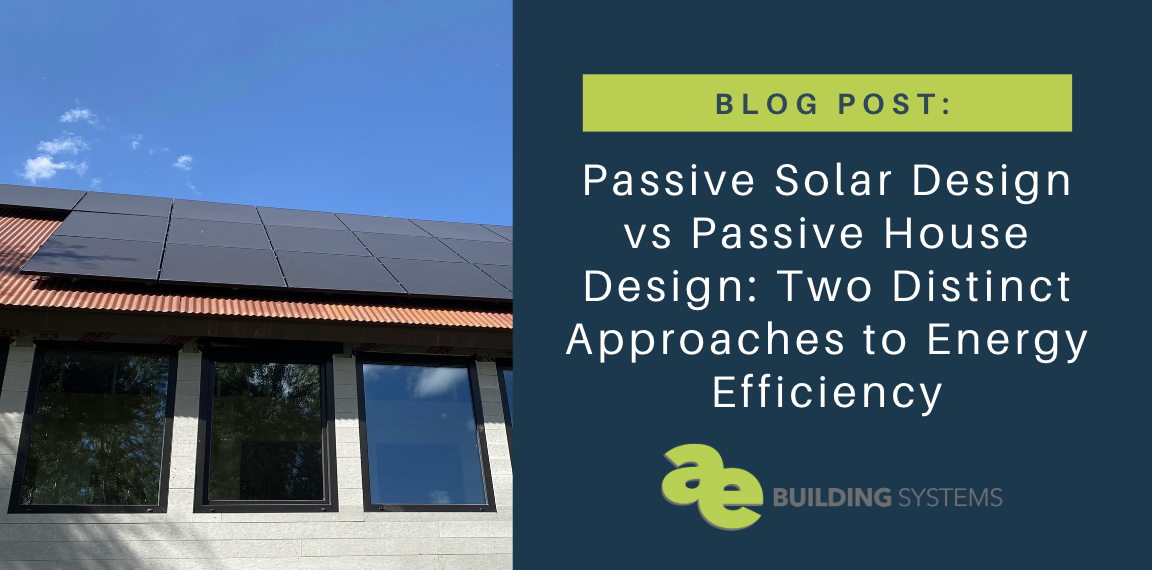Passive is passive, right?
When someone talks of passive designs, they are pretty much the same, correct?
While both Passive Solar Design (PSD) and Passive House (PH) may sound similar, they are actually two distinct approaches to design and construction. They often get lumped in the same category, and people can confuse the two easily. They have many similarities and share a few goals and approaches, but they are not exactly the same. Let’s break down a few of the qualities of each.
Passive House Approach:
A Passive House (or Passivhaus) focuses on a few core principles:
- Airtightness: Goal is to build a building as airtight as possible to prevent heat loss through drafts or thermal bridging.
- Thermal Boundaries: Goal is to have continuous insulation around the outer perimeter of the building to create a defined thermal boundary.
- HRV Usage: Use a heat-recovery ventilator to allow fresh air into the home without the need to open windows.
- High-Performance Windows & Doors: Special attention goes into the selection of windows and doors to ensure minimal heat loss at these openings.
- Thermal-Bridge Free: While eliminating thermal bridges entirely is likely not possible as there are some tricky areas, the energy modeling accounts for all thermal bridges in the building and minimizing them is critical for meeting PH certification requirements.
Passive House Design’s approach is focused on heat losses rather than solar gain, and while it may take solar positioning and thermal gains or losses based on the house’s orientation into consideration, that is just part of the equation. Passive House design is focused on minimizing temperature swings for improving comfort within the house. Passive houses don’t rely on the sun to get to their energy-efficiency goals. The solar piece might be like the cherry on top to help a house perform efficiently.
Passive Solar Approach:
Passive Solar Design is focused on leveraging the sun to heat and cool a home. The orientation of the home becomes extremely important. Often described as the “glass and mass” approach, the focus is largely on positioning large amounts of glass toward the South to maximize the sun’s warmth, as well as incorporating significant thermal mass to store the sun’s heat which can be released from that thermal mass for hours later. That said, Passive Solar Design considers more than just orientation and thermal mass. While less important, PSD also considers zoning, shading, insulation, ventilation, and convection concepts.
Passive Solar Design homes are often designed to operate with minimal (or without any) mechanical cooling or heating, as much as the climate allows. These homes may incorporate airtightness, but that is not the most important focus of the design, as compared to Passive House design.
Related, But Different: Passive Solar vs. Passive House Design
Based on a quick look, it’s easy to see that both design approaches have a similar goal of creating a more passive approach to energy efficiency and overall comfort in a home. The execution and the core focus, however, are extremely different. Passive Solar is focused on leveraging the sun and mass to achieve this goal, but so much of this approach is based on limiting factors with weather/solar availability, inconsistencies in temperatures, and a less calculated approach.
Passive House Design focuses on calculated steps to achieve an optimally efficient home with minimal thermal bridging, air leakage, and heat loss. The Passive House Design can more accurately predict the comfortability of a home based on the design, while still accommodating for whatever temperatures are waxing or waning outside. Passive House Design doesn’t discount passive solar concepts (e.g. Mass and Glass) but instead incorporates them within their design as part of optimizing the whole design as a system of systems.
It’s important for homeowners and designers to understand the subtle differences here. While Passive Solar Design paved the way, in many respects, for the Passive House movement to emerge, Passive Solar often falls short of meeting energy-efficiency goals for homeowners.
At AE Building Systems, we lean more into the Passive House direction because it IS so much more comprehensive for homeowners who want to build with efficiency in mind. We also see Passive House Design working better in our region here in Colorado where intense sun from a bluebird day can make some PSD homes a hotbox, forcing residents to turn on their air conditioning on a cold day, which is counterproductive! The shoulder seasons of fall and spring when the sun is still lower in the sky can also be quite difficult to regulate.
Thinking of building a home that is a little more passive, and works FOR you in the long run? Start by talking to our team about how to pursue your goals. We can help point you in the right direction on products, ideas, designers, and more!


who is manufacturing solr heatig panels today?
Keith … we are not aware of heating panel manufacturers.